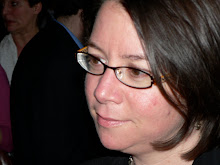Our spring break in Northern Arizona also included a day at Canyon de Chelly. I learned why it is pronounced “shay”: the Navajo word is Tseyi, meaning “within the rocks,” and when the Spanish came along they transliterated that to Chelly and added “Canyon de,” which was redundant. An amusing representation of the cultural mixing and misinterpreting of colonialism. We took a driving tour into the canyon. This canyon is less spectacular and more intimate than Monument Valley, more about the human history. The big attraction for people like us is the cliff dwellings and petroglyphs and pictographs, which are amazing. But also it was interesting to learn that plenty of families still live in Tseyi, especially in the summer; they farm, and graze horses and sheep, and overall have a life not entirely unlike the people who built those cave dwellings.
Here we are outside our tour vehicle with our guide, Perry, on the right. Much more comfortable than the open-air truck in Monument Valley, but much less visibility.
The canyon is pretty spectacular when you get all the way into it. Car on the lower right for scale.
The drive is all through the "wash" of the river that flows in the canyon, mostly just a few inches deep.
There are cliff dwellings everywhere in the canyon; here are some we got relatively close to. Note both levels.
It's interesting to think about; why build there? There is good shelter and good isolation from invaders (human or animal), but man, the work of just getting in and out of your little town all the time, and carrying water? seems like a lot. Another possibility is that there were dwellings all over the canyon, and the cliff dwellings are the only ones
left (because they are protected from the elements, and hard to get to).
Pictographs and petroglyphs are a major attraction. I learned that pictographs are drawings on rock, added with paint or stain; petroglyphs are drawings pecked into the rock. As for what they mean, very hard to say. Some of them seem like they might be pieces of a written language like Egyptian hieroglyphs, some seem to show scenes of events like hunting parties, some seem like art, some seem like graffiti. It is undeniably something, though, to be looking at marks made by ancient people.
Petroglyph from Canyon de Chelly:
Petroglyph from Monument Valley:
Back to Canyon de Chelly for pictographs: these are antelopes.
You may have to enlarge this one to see the pictographs: imagine someone climbing up to the base of that cliff face to do these. wow.























































